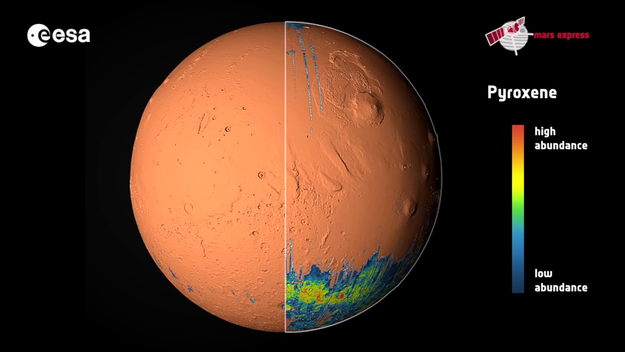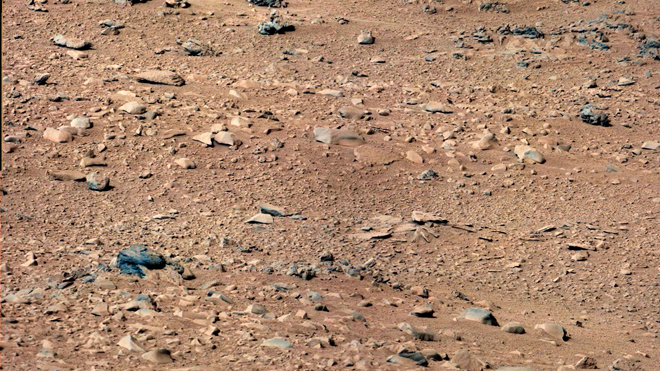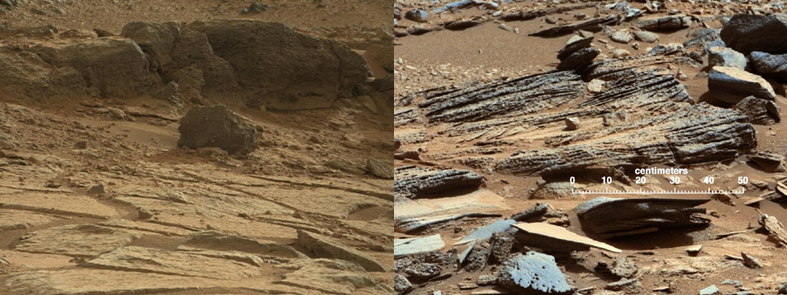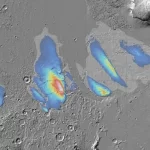What a challenging couple of weeks for my family. Who knew that moving in the 21st century was no different from moving in the 20th. All the things that can go wrong usually do and one of them was our phone and Internet connection. At my old house my landline was buried in a PVC pipe under my patio and secured at both ends with closed boxes. No hanging wires. No chance for the signal to go down. At our new place, a fully remodeled apartment situated in mid-Toronto, we went without a landline for our first week and after finally resolving the technology issues saw it go down again for a three day period because a telephone technician working remotely on someone else problem accidentally disconnected our line. Finally, all connectivity issues have been resolved in the last two hours and here’s hoping I can begin posting again.
Today I focus on three Mars’ stories. One involves a Curiosity image of a rock that looks like a rat scurrying about on the surface of Mars. First reported by a Japanese blogger with an active imagination, the story soon showed up in major news media and made the rounds for about 24 hours. All I can say is that lighting and shadows can do so amazing things in a photograph.
Judge for yourselves what Curiosity saw. The likeness of a rat appears sandwiched between two rocks roughly two-thirds from the bottom of the picture below on the left side. If you look closely there is a rock below the rat that looks like a severed fish tail. I wonder if the rat caught the fish.
On to more serious Martian announcements. Of greater importance in the last week, a Martian spacecraft celebrated a decade in orbit around the planet – the European Space Agency’s (ESA) Mars Express. In celebration ESA released a video atlas of the planet featuring a map showing the planet’s complex geography and geology, and highlighting mineral distribution in deposits produced through vulcanism, past water events and ongoing wind and dust storm activity.
An added bonus from Mars Express‘ ten year coverage of the planet are its many close encounters with Phobos, the Martian moon. One of those encounters in 2010 took the spacecraft to within 67 kilometers (less than 40 miles) of this captured asteroid. The video by Mars Express in another Phobos encounter dramatically shows the moon passing in the foreground with the planet Jupiter behind, a truly remarkable piece of footage.
For a mission that upon its arrival near Mars began with its lander, the Beagle 2, crashing to the surface, Mars Express has since been a ringing success. It is expected to operate for many years into the future giving us an unparalleled view of the planet surface while keeping an eye on Curiosity and NASA’s nine year wonder, Opportunity. Last month the latter achieved a new milestone surpassing 35.76 kilometers in travel distance since arriving on the planet. Only Lunokhod 2, the Soviet rover of 1973 has outdistanced it having achieved 37 kilometers on its lunar mission.
And speaking of Curiosity, it has experienced ups and downs of late with a number of shutdowns and reboots to shakeout some of the bugs that seem to have plagued it. It has drilled into two rocks and extensively photographed what appears to be ancient stream beds. In total it has traveled less than a kilometer to date (about half a mile). But now it is ready to start doing some real long distance driving across the bottom of Gale Crater and on to Mount Sharp at the crater’s centre. The route has been mapped and it is expected to take about ten months to travel the 8 kilometers (5 miles). Why so long? Because Curiosity will make stops along the way. For example it has a planned stop to examine the remains of some of the landing gear that got it to Mars. It will do more drilling of interesting rock samples. Plans include checking out two rock formations, one called Point Lake (seen below on the left), the other given the name Shaler (seen on the right). Both appear to be remains of rocks formed by chemical or wind-induced weathering.
And that’s the real news from Mars. And now back to unpacking here on Earth.
Thanks for dropping by.

















